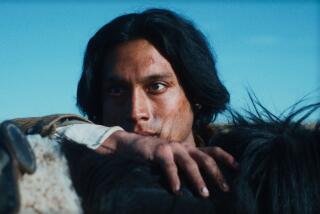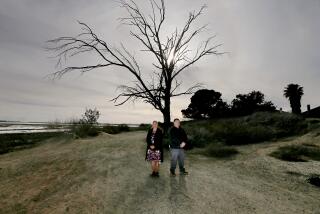Battered Spirits of Modocs Lure 250 to Scene of Forgotten War
- Share via
LAVA BEDS NATIONAL MONUMENT, Calif. — As wars go, it was a faint blip in the annals of human experience--89 killed, a few hundred wounded.
Yet, the six-month Modoc War waged in the northeast corner of California from November, 1872, to June, 1873, virtually ended the 10,000-year-old Modoc civilization, one of the oldest cultures documented by archeologists in North America.
Numerous descendants of the Indians, soldiers and settlers who were combatants in the war met for three days this week on the lava beds battlefield, which is strewn with jumbled boulders, lava flows, deep crevices, craters and caves. The meeting led to emotional and philosophical encounters.
Eye on History
The National Park Service Symposium on the Modoc War--held Sunday through Tuesday--attracted more than 250 men and women from the West--descendants, historians and others fascinated with the little-known episode of history.
“Descendants of Modocs, of soldiers and early settlers who lost their lives in the war or who fought and lived through it, identify themselves to me from time to time when visiting Lava Beds,” said Doris I. Omundson, 48, superintendent of the national monument.
Omundson said the symposium was inspired by her realization that many of the descendants had never met one another. She recruited Klamath Falls historian Francis (Val) Landrum to chair the event. Other historians familiar with the war agreed to address the group.
It was a war of five major battles and several skirmishes. The 52 warriors of the Modoc fighting force stood off an army of 1,000 soldiers during a six-month siege in which they defended a natural lava fortress called the Stronghold, a network of caves linked by natural trenches. The Indians smuggled some supplies past the surrounding U.S. soldiers, but eventually ran low on water and food and were forced to surrender.
Only six Indians were killed in the fighting while 53 federal troopers lost their lives, including Gen. E.R.S. Canby. Also killed by the Modocs were 17 civilians, two members of the Oregon militia and two government Indian scouts.
Four Modocs were killed by a lynch mob after they had been taken prisoner, one warrior committed suicide rather than surrender and four Indian leaders--Captain Jack, Schonchin John, Boston Charley and Black Jim--were sent to the gallows four months after the war ended.
During the symposium, a plaque listing the names of everyone killed in the war was dedicated. The monument superintendent observed:
“They were all doing their jobs, the soldiers, most of them new immigrants from Europe to America, the 60 officers, several graduates of West Point, the Indians who loved their tribal lands. Each one wanted the best for themselves and their families. We remember all of them who participated in the anguish of the tragedy that was the Modoc War.”
Author Richard Dillon, 65, former head librarian of San Francisco’s Sutro Library and author of “Burnt-Out Fires,” a 1973 book about the Modoc War, keynoted the event, saying the real heroes were those who tried, unsuccessfully, to prevent war.
Cheewa James, 48, great granddaughter of Shacknasty Jim, a prominent Modoc warrior, was at the gathering. James is a former Klamath Falls television anchorwoman who now works in public relations for the Sacramento schools.
“We need to be very careful of the way we interpret history,” she cautioned. “We need to understand the implications. My great grandfather and his people were called savages. They weren’t savages. They were human beings with their own unique language and culture living in peace and harmony generation after generation for centuries until the settlers entered the picture and pushed them aside. They were fighting for survival.
“What kind of men were these Modoc warriors? Were they, as history records, renegades who murdered without thought? I think not. One has to be careful making judgments.”
James noted that 150 to 160 Modocs were holed up in the rock fortress those six months, the 52 warriors and their families. Among those born during the siege was James’ grandfather.
Strong Feelings
“On top of that my great grandfather’s two brothers, Shacknasty Frank and Ellen’s Man George, were killed in the fighting,” she continued. “Can you imagine the condition of those Modocs, half-starved, physically and psychologically torn up fighting against overwhelming odds?”
Many other descendants of the Modocs, seated side-by-side at the symposium with the grandchildren and great grandchildren of soldiers and settlers, aired strong feelings about the war.
“It wasn’t my people’s war. They were reacting to the years of provocations by the white settlers who stole the Modoc land and killed our people . . . as happened in 1854 when 41 Modocs out of 68 were ambushed, shot and killed for no logical reason,” said Lynn Schonchin, 41, a Chiloquin, Ore., high school teacher and great grandson of Schonchin John, one of the four Modoc leaders who were hanged.
Killings by both Indians and settlers occurred from time to time over a 20-year period leading up to the Modoc War.
Next to Schonchin sat Melissa Meacham Stewart, 52, of Portland, Ore., great granddaughter of Alfred B. Meacham, superintendent of Indian affairs for the Modocs and a member of a peace commission that attempted to stop the fighting. “I grew up on stories my mother and grandmother told about the Modoc War,” said Stewart.
The peace commission, which also included Gen. Canby, was attacked by Modocs and Canby was killed. Meacham was shot four times and partly scalped by Schonchin’s great grandfather, but survived.
Stories Recalled
Orthopedic surgeon Dan Halferty, 65, came down from his home in Portland, Ore., for the conference. His grandfather was Capt. Oliver Cromwell Applegate of the Oregon Militia. “I lived with my grandfather for a year when I was 10 and he was 87 in 1932. I would sit around and listen to his stories about the Modoc War,” Halferty recalled.
“He was 27 when he fought in the Modoc War. My grandson is 27, flying helicopters for the Navy in the Mediterranean. I’m trying to put all that in perspective.”
The descendants of the Indians, soldiers and settlers walked together for miles exchanging stories as they crossed the desolate battlefield. Don Colwell, 75, was among them. The war started at his grandfather’s ranch when Indians stole butchered beef hanging out to cure for the soldiers and burned the ranch house.
Margaret Powell, 66, was another descendant of a settler family. Her grandparents’ home was converted into a fort during the war.
After the war, 301 members of Captain Jack’s small Indian band were exiled by train to the Quapaw Indian Agency in Oklahoma, “banned from California forever.” Today there are nearly 1,000 Modoc descendants, most of them in the Klamath Falls, Ore., area and some still in Oklahoma. But there are no full-blood Modocs left. Their bloodlines are mixed with the Klamath, Snake, Sioux and other tribes and with other races and nationalities.
When the Modocs were exiled, the government insisted that they no longer speak the Modoc language or practice their culture, religion or other Indian ways.
“By the time my father was born in Oklahoma in 1900, the dominant culture succeeded in blowing the old Modoc civilization to the winds,” said Cheewa James.
“They say the Modoc culture is dead, that they took the life and spirit out of the Modocs during the Modoc War,” spoke up Tom Ball, 38, a Modoc from Portland, his voice choking with emotion.
“I go to the Modoc cemetery at the old Klamath Indian Agency. I clean off the graves. I can feel their spirits. My people often hear the drums still beating out here on the Lava Beds, the sacred land of the Modocs at the foot of snow-covered Mount Shasta, our sacred mountain. As long as the spirits are here our culture will never be lost.”
More to Read
Sign up for Essential California
The most important California stories and recommendations in your inbox every morning.
You may occasionally receive promotional content from the Los Angeles Times.













